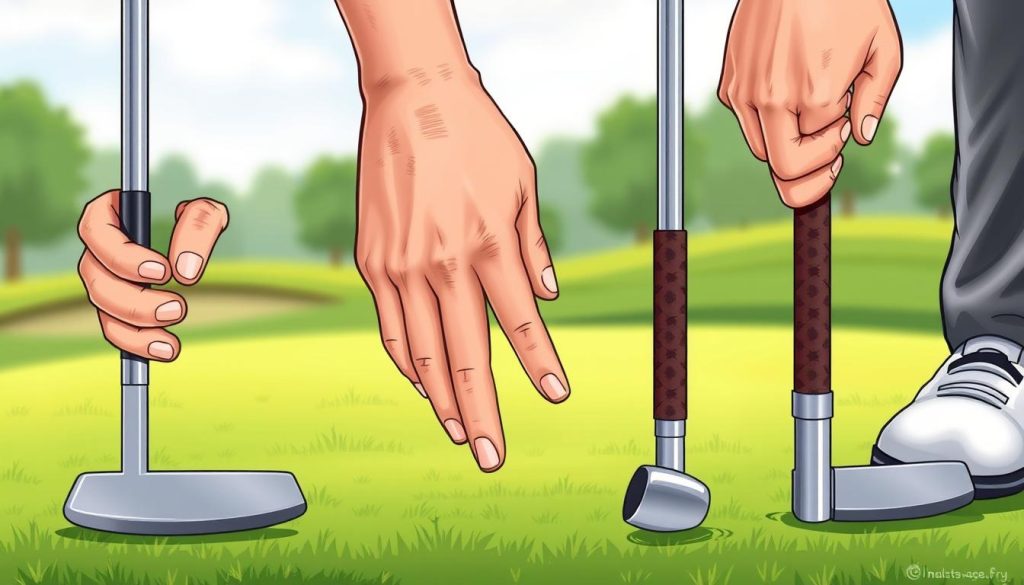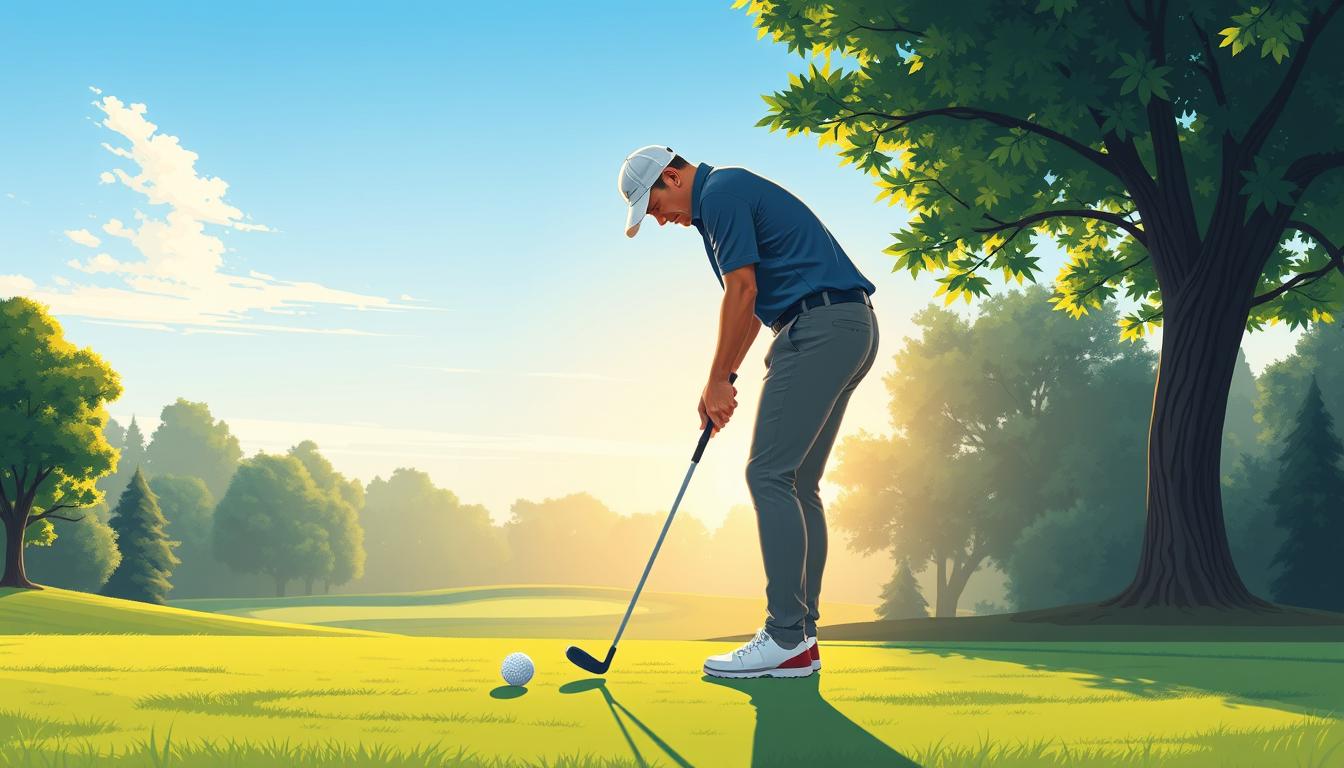Mastering your putting stroke is key to lowering your golf scores. This guide covers essential golf putting techniques. It helps you develop a consistent stroke and perfect your pendulum motion. By learning the basics and practicing, you’ll sink more putts and boost your game.
Brad Faxon, known for his putting, stresses the 2:1 tempo ratio between backswing and downswing. This rhythm, along with a customized putter and finger-based grip, is the base of good putting. He also suggests finding a comfy stance and simplifying alignment to better your putting.
Studies of over 1,000,000 golf swings show pros limit wrist motion for consistency. They keep a steady tempo of 72 to 80 beats per minute for a smooth motion. Path consistency and face control are key to accurate putts.
Key Takeaways
- Maintain a 2:1 tempo ratio between backswing and downswing
- Customize putter length to match your natural stance
- Use a finger-based grip with light pressure for better control
- Focus on alignment and visualization to improve accuracy
- Limit wrist motion for a more consistent putting stroke
- Practice path consistency and face control for better direction
- Use training aids like putting strings to enhance stroke consistency
Understanding the Fundamentals of a Perfect Putting Stroke
Improving your golf game starts with mastering putting. A perfect putting stroke needs technical skill, spatial awareness, and mental focus. Let’s explore the essential elements for a successful putt.
The Science Behind a Consistent Stroke
A consistent stroke is key. The putter face’s impact on ball direction is five times more than the swing path. Aim for a centered strike with a square path and club face at impact. Control the club head’s velocity and ball launch height for the best results.
Key Components of Proper Setup
Your stance and grip are crucial for success. The setup is 80-90% of putting technique for all players. Focus on these key points:
- Maintain a steady posture
- Align your shot correctly
- Grip the putter comfortably
- Ensure clean contact with the sweet spot
Building Your Foundation for Success
Practice consistently with quality drills to build a solid foundation. Reading greens accurately is key to becoming a skilled putter. Understand the surface’s shape, slope, and grain to predict the ball’s path. Tools like AimPoint Express can enhance your green-reading skills.
| Distance | Make Percentage |
|---|---|
| 8 feet | ~50% (PGA Tour players) |
| 10 feet | Best chance for recreational golfers |
Even PGA Tour players make only half their putts from 8 feet. Focus on putts within 10 feet for better success. With dedicated practice and focus on these fundamentals, you’ll master the perfect putting stroke.
Mastering Wrist Control and Movement
Wrist control is key for consistent and accurate putting. Learning to control your wrist movement can greatly improve your game.
Limiting Wrist Range for Better Control
Keeping your wrist still during putting is crucial. Professional golfers aim to limit wrist movement, especially in the lead wrist. This helps keep the putter face angle steady.
Common Wrist Motion Mistakes
Many beginners make the mistake of moving their wrists too much. This can change the putter face’s angle, affecting how the ball flies. Moving the wrists in the wrong way can also mess up the ball’s contact with the putter.
Professional Techniques for Wrist Stability
Pro golfers keep their wrists stable. They open the putter face on the backswing and close it on the downswing. To get better at wrist stability, try these drills:
- Practice with a wrist stability mode device to analyze misses and improve putter direction
- Use video analysis with wrist motion data to identify areas for improvement
- Focus on short putts to build confidence before increasing distance
Mastering wrist control and using these techniques will help you put more consistently and accurately.
The Art of Tempo and Rhythm in Putting
Mastering putting stroke tempo is key for golfers wanting to get better. A steady putting rhythm boosts control and accuracy on the green. The secret is knowing and using the right 2:1 tempo ratio in your stroke.
This ratio means your backswing should last twice as long as your forward stroke. This rhythm helps you make smoother, more accurate putts. Regular practice builds muscle memory and boosts your putting skills.
Using a metronome during practice can help you get your tempo right. It keeps your rhythm steady and helps you feel the timing. Start slow and get faster as you get more comfortable.
| Putting Statistic | Average | Impact of Proper Tempo |
|---|---|---|
| Putts per round | 36 | Potential 2-3 stroke improvement |
| Three-putt frequency | 20-30% | Reduction to 10-15% |
| Distance control accuracy | 60% | Increase to 75-80% |
About 40% of putting strokes happen in a round of golf. By working on your tempo and rhythm, you can lower your scores. This improves your performance on the green.
Face Control and Path Dynamics
Improving your golf game starts with mastering putter face control and putting path dynamics. These skills are key to hitting your putts straight and accurately. They are essential to focus on.
Understanding Face Angle Impact
The angle of your putter face at impact is crucial. A square face sends the ball straight. But an open or closed face can make it veer off course. Use a laser alignment tool to see your face angle and improve control.
Path Options for Different Putting Styles
Choosing the right putting path is vital. Paths include straight-back-straight-through, slight arc, and strong arc. Try them out to see which fits your style best. Your path should match your natural stroke for the best results.
Correcting Common Path Issues
Many golfers face problems with out-to-in or in-to-out strokes. These can make your putts unpredictable. Use alignment aids and putting gates to correct these issues. Regular practice will make these corrections second nature.
| Path Issue | Effect on Putt | Correction Tip |
|---|---|---|
| Out-to-in | Pull or slice | Focus on swinging through to your target |
| In-to-out | Push or hook | Practice with alignment sticks parallel to target line |
| Inconsistent arc | Varied direction | Use an arc putting mat for consistent practice |
By working on putter face control and path dynamics, you’ll see big improvements. Practice is the key to mastering these skills and lowering your scores.
Putting Stroke Tips Guide
Mastering your putting stroke is key to lowering your golf scores. This guide shares tips on practice drills, choosing the right equipment, and mental strategies to boost your putting skills.
Essential Practice Drills
Improve your putting stroke with these effective drills:
- Path length exercise: Place two tees just wider than your putter head and practice swinging through without touching them.
- Grip consistency drill: Use a grip trainer to maintain proper hand position throughout your stroke.
- Clock drill: Set up golf balls in a circle around the hole and putt from different angles to improve your aim.
Equipment Considerations
Choosing the right golf equipment for putting can significantly impact your performance:
| Equipment | Consideration | Benefit |
|---|---|---|
| Putter Length | Match to your height and stance | Improved control and consistency |
| Putter Weight | Heavier heads (e.g., Pyramid iCOR Putter) | Enhanced stability and stroke correction |
| Putter Face | Grooved inserts (e.g., TaylorMade/Rossa) | Better impact and roll characteristics |
Mental Approach Techniques
Develop a strong mental game to complement your putting stroke:
- Visualization: Picture the ball’s path to the hole before putting.
- Pre-putt routine: Establish a consistent routine to build confidence.
- Positive mindset: Approach each putt with the expectation of success.
By using these putting stroke drills, choosing the right equipment, and adopting effective mental strategies, you’ll improve your putting skills.
Grip Techniques and Hand Position

Learning the right putting grip and hand position is key to bettering your golf game. The correct grip can change your putting stroke, making your putts more consistent and accurate.
There are many putting grip techniques to try. The reverse overlap grip is a favorite, while the cross-handed and claw grips are popular among pros. Each grip has its own benefits, so it’s important to find one that feels right for you.
Brad Faxon, known for his great putting, suggests a finger-based grip. This method helps with feel and control, making it easier to manage the putter’s face angle. Studies show that keeping the face angle close to square improves putting accuracy.
When improving your hand position for putting, keep your grip pressure steady. Many golfers prefer a light to medium grip, which helps with feel and control of the putter.
- Try out different grip styles to find what works best for you
- Practice keeping your grip pressure consistent
- Work on keeping your wrists stable during the stroke
- Use alignment aids to ensure proper hand placement on the putter
The aim is to develop a consistent putting stroke. By mastering your grip and hand position, you can improve your game and lower your scores on the green.
Advanced Distance Control Methods
Mastering distance control in putting can greatly improve your golf game. Studies show that golfers who focus on advanced putting techniques can lower their handicap and save strokes. Let’s explore strategies for long putts and speed control to enhance your performance on the greens.
Long Putt Strategies
When facing long putts, many golfers hit harder instead of adjusting their stroke length. PGA pro Katie Dawkins suggests using momentum over force for consistency. Keep a pendulum-like motion and have soft hands to avoid jerky movements at impact.
Speed Control Techniques
Controlling putting speed is key for accuracy. Practice keeping the same tempo in your putts, adjusting only the stroke length. Use a rhythm like “tick-tock” or “1-2” to keep your tempo consistent. This helps you gauge distance better.
Practice Routines for Distance Control
Here are drills to improve your distance control:
- Ladder drill: Place markers at increasing distances and practice hitting to each one
- Visualization exercise: Before putting, imagine the length of stroke needed for different distances
- Three-putt reduction: Focus on lagging long putts close to minimize three-putts
| Skill | Amateur Average | After Practice |
|---|---|---|
| Three-putt frequency | 3.2 per round | 1.8 per round |
| Putting accuracy | 65% | 78% |
| Strokes saved | – | 2.5 per round |
By using these long putt techniques and focusing on speed control, you can quickly improve your scoring. Regular practice of these methods can lead to a significant reduction in three-putts and enhance your overall putting performance.
Transitioning from Practice to Performance
It’s key to move from practice to real putting on the golf course. What works on the practice green might not work in the game. To get better, practice in ways that feel like the real game.
Try playing a quick nine-holes on the practice green. It feels like real game pressure and helps you get used to different greens. Remember, pros only make a 50% chance of an 8-foot putt, so don’t worry if you miss sometimes.

- Use balls of different sizes to challenge your stroke
- Practice one-handed putting to enhance feel
- Find the equator of the golf ball for better alignment
- Putt from the fringe to improve distance control
- Try the push drill to maintain a straight stroke path
When you’re on the course, stick to a good green reading routine. Imagine the green covered in water to see slopes and breaks. This can really help you make more putts and improve your game.
Missing the ball within 10 feet of the hole can lead to missing easy putts. Work on controlling your distance in practice to avoid this. By using these strategies, you’ll see a big improvement in your putting when it matters most.
Conclusion
Mastering putting is key to better golf scores. Putting makes up nearly half of a round’s strokes. By following this guide, you’ll improve your putting skills.
Practice is essential. Golfers who practice putting for 30 minutes, three times a week, see a 21% boost in consistency. Try the Gate Drill to improve your stroke by 27%.
Pay attention to your grip too. 49% of pros prefer a light grip for better feel and response.
Good equipment and tech also help. Flat putting mats can increase amateur proficiency by 35%. Visualizing your putt can also boost confidence and performance.
Stay positive and focused to lower your scores. Putting needs patience and a grasp of the basics. With effort and the right methods, you’ll see big improvements.
FAQ
What is the most important aspect of a consistent putting stroke?
How can I improve my wrist control during putting?
What is the ideal tempo for a putting stroke?
How does putter face angle affect my putts?
What are some effective putting stroke drills?
How important is grip technique in putting?
How can I improve my distance control on long putts?
What mental techniques can help improve my putting?
How do I transition my putting practice to real-world performance?
What equipment considerations should I keep in mind for putting?
Source Links
- https://skillest.com/blog/putting-like-brad-faxon-tips-to-improve-your-putting-stroke/
- https://hackmotion.com/putting-stroke-tips/
- https://skillest.com/blog/master-the-art-of-golf-putting-a-comprehensive-guide-for-beginners/
- https://golfinsideruk.com/putting-technique-the-putting-stroke-explained/
- https://practical-golf.com/putting-tips
- https://hackmotion.com/wrist-action-in-putting/
- https://golfforbeginners.academy/9-essential-golf-putting-tips-for-beginners/
- https://puttaim.com/blogs/news/putting-tip-tempo?srsltid=AfmBOormkwiTYfwaJoPQ3fYgZaTiOVoqtur44ibT3X1g2ghA-XkV0uoZ
- https://itrgolf.co.uk/blogs/advice-information/mastering-the-art-of-putting-in-golf-a-comprehensive-guide?srsltid=AfmBOor5k_iOnfDHXNbaYisLfSnjkf27CcyeMeGXvMWojNcfE2FTEq–
- https://hackmotion.com/golf-ball-flight-laws/
- http://www.wrightputtingdynamics.com/laser-optics.html
- https://skillest.com/blog/mastering-the-follow-through-in-your-golf-swing/
- https://pyramidgolf.com/blogs/news/top-10-putting-stroke-tips-for-a-smooth-steady-roll
- https://alamocitygolftrail.com/dave-stocktons-all-time-top-ten-putting-tips/
- https://rotaryswing.com/c4/112382-left-hand-grip-for-perfect-putting-stroke
- https://www.golfmonthly.com/videos/putting-tips/claw-grip-for-putting-how-it-works
- https://puttingworld.com/putt-for-par/
- https://www.golfmonthly.com/videos/putting-tips/putting-drills-for-distance-control
- https://www.performancegolf.com/blog/7-golf-putting-mistakes-that-can-crush-your-confidence?srsltid=AfmBOorP8772eG8ES7S7vkTyvG-m-rmq6MhSnT1tIU0_XXlylW53_jhV
- https://www.golfmonthly.com/tips/putting-tips/32-best-ever-putting-tips
- https://patch.com/pennsylvania/doylestown/mastering-art-putting-guide-lower-scores
- https://twoputtpro.com/blogs/putting-ball-and-drills/better-putting-stroke?srsltid=AfmBOor5fazm-KMM3BjIIEnPpnFTYatIA6O0k5mpHH9bhYUXAKWNjyU6
- https://foxburggolf.com/t/mastering-jack-nicklauss-putting-stroke-tips-and-techniques/3818


